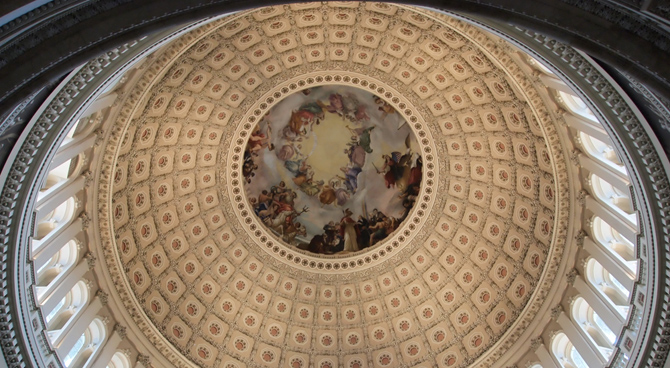The numbers reveal that a robust economy, not higher taxes, is the most reliable way to increase federal revenue.
By Michael Solon
Feb. 2, 2015 7:37 p.m. ET
The recent rule change by House Republicans to incorporate the macroeconomic impact of major legislation into official budget estimates—“dynamic scoring”—has triggered heated criticisms. But three decades of hard accounting data, in addition to supporting the rule change, should prompt Washington to reconsider the way it thinks about what drives federal revenues.
Since 1984 the Congressional Budget Office has tracked all revisions to its triennial projections of federal revenues, outlays and deficits to account for economic, technical and legislative changes. Its data—from the “Changes in CBO’s Baseline Projections” tables that are published annually in the CBO Budget Outlook, the Budget Update and the Analysis of the President’s Budget—indicate which federal policies grew or shrank the economy significantly enough to generate measurable revenue gains or losses. The data also reveal the failures of core Democratic economic policies and flaws within the CBO’s current economic model.
One fact above all others emerges from the data: Economic growth is the single most powerful determinant of federal revenues.
The CBO today projects that if annual gross domestic product were to average one percentage point higher (in real terms), there would be an additional $2.9 trillion in revenues and $370 billion less in federal spending over a decade. Conversely, its 10-year revenue projections have fallen $5.6 trillion since 2007. Most of the lost revenue was not due to the financial crisis and recession, but to the historically weak recovery.
Here’s another vital fact: Economy-driven revenue changes can dwarf legislative changes. Consider the budget summit deal enacted in November 1990. The CBO projected that the law’s variety of tax hikes would raise $159 billion in revenues over five years. Two months later the CBO reported that the 1990 recession would cut revenue projections by $206 billion—wiping out 130% of the revenue supposed to be gained by higher taxes.
Or consider a more recent example: In December 2013 the tax cuts for upper incomes and small businesses enacted in the George W. Bush years were allowed to expire, effectively a $615 billion, 10-year tax hike. Yet the CBO’s revenue estimates were lowered in both February and August of 2014, because of economic weakness. The projected revenue loss over a decade: $1.9 trillion.
A week ago Monday the CBO reported additional 10-year revenue losses of $234 billion from slower growth, offsetting three-fourths of the $320 billion in new taxes proposed in the president’s State of the Union address the previous Tuesday.
Economic growth also can add far more to revenues than legislatively driven tax hikes. The CBO projected that President Clinton’s 1993 tax increase would raise $268 billion over five years. But after the 1997 bipartisan agreements on budget restraint, welfare reform and capital-gains tax cuts, revenues surged, which the CBO said in 2000 arose “from the strength of the economy and changes in characteristics of income.” The CBO’s projected revenues for that year “are now $303 billion more than estimated in 1997.”
In other words, the government gained in one strong year more than the first five years of Clinton’s 1993 tax hike. Overall, an extra $1.34 trillion in revenues flowed from September 1997 to January 2001 solely for economic reasons—five times higher than the projected revenues from the 1993 tax hike.
The CBO data also help identify the periods and policies where both public revenues and private incomes grew the most or the least. These data reveal flaws both in Democratic economic remedies and within the CBO’s economic model.
Once President Obama ’s agenda of stimulus and expansion of government power was implemented—along with the Federal Reserve’s record low interest rates—the CBO projected strong economic growth after 2010. In the three annual budget reports after the stimulus bill’s passage, the CBO projected average GDP growth for 2011, 2012 and 2013 of 4.3%, 3.8% and 3.4%, respectively. Instead, growth averaged 2%.
The Clinton administration is another example. Republicans took control of Congress in 1994, and over the next few years pushed through restraints on spending and regulation. As a result of declining federal borrowing, interest rates also were lower. After 1997 the CBO repeatedly projected real gross domestic product growth outside the initial year to drop to a 2.1% average during 1997 to 2000. Yet actual GDP growth averaged 4.7%.
Among many other changes, the 1986 Tax Reform Act lowered the top marginal income-tax rate to 28% from 50%. Instead of projecting an economic boost, the CBO immediately lowered projected average gross national product growth rates for 1987 through 1989 to 2.9% from 3.3% (CBO projections were changed to GDP in 1992). The final GNP figures averaged 3.8% growth, including a strong 4.2% surge in 1988 when the full rate reductions kicked in.
Neither Democrats nor the CBO appear to alter their assumptions or correct their model for economic reality. Both discount the impact of marginal tax-rate changes. The CBO has repeatedly projected since 2001 that the U.S. would enjoy numerous years of 3% or higher growth. But the only two years that occurred were in 2004 and 2005, immediately after the accelerated reductions in virtually all marginal tax rates.
The overwhelming weight of CBO accounting supports dynamic scoring. CBO revisions confirm that slow growth since 2007 has triggered a massive revenue gap, that all revenues lost in past recessions have been recaptured in recoveries until the current one, and that pro-growth policies have delivered revenue surges.
No evidence in the CBO data appears for the macroeconomic feedback that Democrats claim and the CBO assumes from stimulus spending. The data highlight the economic and fiscal benefits to the private and public sectors from tax reductions and “austerity” programs that Republicans tend to pursue but the CBO and Democrats tend to dismiss. Such findings may not change the CBO’s future projections or Democratic policy assumptions, but these are the undeniable facts of the CBO’s past accounting.
Mr. Solon was budget adviser to Senate Republican Leader Mitch McConnell and is currently a partner at US Policy Metrics.





